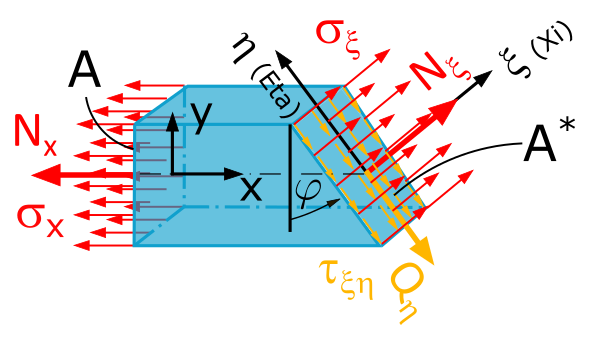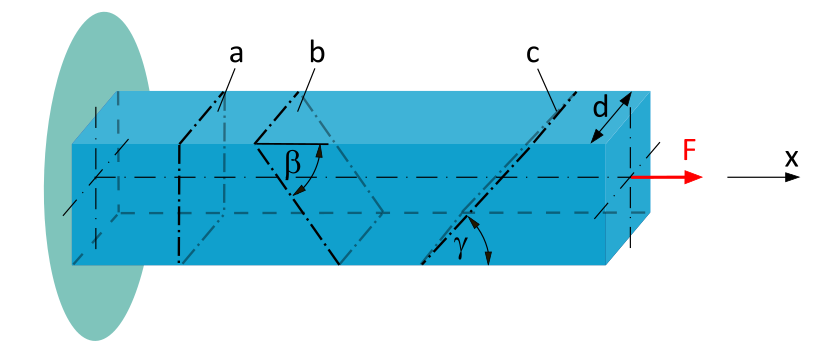Step 4: Deriving the Formulas for Normal Stress \(\sigma_\xi\) and Shear Stress \(\tau_{\xi\eta}\) from Previous Results
Ready for the next mission? This time we're hunting down the formulas for normal and shear stress at an arbitrary cutting angle \(\varphi\).

Let's crack the code for \(\sigma_\xi\) first:
With some trigonometry magic and our previous results, we conjure up the formula:
We can simplify this equation further. Since \(\sigma_x = \frac{N_x}{A}\), we have:
Pretty elegant, huh? We already know \(\sigma_x\) and \(\varphi\) is simply the cutting angle. But wait, there's more! With another trigonometric formula, we can simplify the equation: With
we get:
(1.4)
See? Now we have the formula for \(\sigma_\xi\) in all its glory!
Next up, let's tackle shear stress \(\tau_{\xi\eta}\). The formula is similar, but we have to be careful:
Again, we use some trigonometry magic and our previous results to create the formula:
We can simplify this equation further. Since \(\sigma_x = \frac{N_x}{A}\), we have:
With another trigonometric formula, we can simplify the equation: With
we get:
Attention! This formula is only valid for a coordinate system where shear stress is positive in the downward right direction.
Why? Let's recall the sign convention for shear stress. It depends on the coordinate system used.
We assumed a positive shear stress in the downward right direction. You can verify this again in the force triangle of Figure 1.2.10.
We need to adjust the sign in other coordinate systems.
-
\(x\),\(y\)-system
$$ \begin{aligned} \tau_{\xi\eta} = -\dfrac{\sigma_x}{2}\bigl(\sin(2\varphi)\bigr) \end{aligned} $$
(1.5xy)
-
\(x\),\(z\)-system
$$ \begin{aligned} \tau_{\xi\eta} = \dfrac{\sigma_x}{2}\bigl(\sin(2\varphi)\bigr) \end{aligned} $$
(1.5xz)
Mission accomplished! With these formulas, you can calculate normal and shear stress at any cutting angle.
By the way: These formulas are brilliant, but not infallible. Don't forget to keep an eye on the units!
P.S.: Thirsty for more math action? Take a closer look at the trigonometric relations. There are more exciting secrets to uncover!
Extra tip: These formulas are incredibly useful when you need to calculate stresses in components. For example, you can use them to determine whether a component can withstand a specific load.

Normal and Shear Stress at an Arbitrary Section Angle
A clamped beam with a square cross-section (side length \(d=20~\mathrm{mm}\)) is subjected to a tensile force \(F=10~\mathrm{kN}\) along the beam axis.
Determine the average normal stress and the average shear stress...
- ...acting in cross-sectional plane a.
- ...acting in cross-sectional plane b (\(\beta = 50°\)).
- ...acting in cross-sectional plane c (\(\gamma = 40°\)).